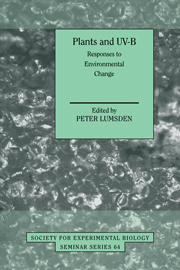Book contents
- Frontmatter
- Contents
- List of contributors
- Preface
- PART I The ozone layer and UV-B radiation
- PART II Effects of UV-B on plants at the cellular level
- PART III Effects of UV-B at the whole plant and community level
- Effects of solar UV-B radiation on aquatic ecosystems
- Assessing the impact of UV-B radiation on the growth and yield of field crops
- Effects of UV-B radiation on plants from agro- and natural ecosystems
- Effects on subarctic vegetation of enhanced UV-B radiation
- Impacts of elevated UV-B on forest ecosystems
- Effects of elevated UV-B radiation and elevated CO2 on heathland communities
- Alterations in competitive balance
- Interations between trophic levels
- Index
Assessing the impact of UV-B radiation on the growth and yield of field crops
Published online by Cambridge University Press: 04 August 2010
- Frontmatter
- Contents
- List of contributors
- Preface
- PART I The ozone layer and UV-B radiation
- PART II Effects of UV-B on plants at the cellular level
- PART III Effects of UV-B at the whole plant and community level
- Effects of solar UV-B radiation on aquatic ecosystems
- Assessing the impact of UV-B radiation on the growth and yield of field crops
- Effects of UV-B radiation on plants from agro- and natural ecosystems
- Effects on subarctic vegetation of enhanced UV-B radiation
- Impacts of elevated UV-B on forest ecosystems
- Effects of elevated UV-B radiation and elevated CO2 on heathland communities
- Alterations in competitive balance
- Interations between trophic levels
- Index
Summary
Introduction
After more than 20 years' research into the effect on plants of elevated levels of UV-B radiation, one might expect it to be a relatively easy matter to predict the impact of future changes in UV-B climate on the growth and yield of important field crops, but this is not the case. Predicting future changes in ground-level UV-B is itself proving very difficult because of uncertainty in trends for future emissions of ozone-destroying chemicals, incomplete knowledge of the atmospheric chemistry involved (see chapters by Webb and by Pyle, this volume) and possible interactions between UV-B and other climate change variables such as CO2 and temperature. Even if future trends were known, recent reviews (for example, Caldwell & Flint, 1994; Fiscus & Booker, 1995) have highlighted the methodological limits of many studies of plant responses to UV-B which make problematic any direct extrapolation to predict likely yield losses at the field-scale. This review of the existing knowledge on field crop responses to UV-B focuses specifically on potential effects on yield. We consider controlled environment, glasshouse and field studies with two questions in mind: (a) will elevated UV-B irradiance alter yields or quality of field-grown crops, and (b) are there beneficial/adaptive effects of UV-B which might be exploited?
Unless otherwise stated, the UV-B quantities discussed below are all in terms of the Caldwell generalised plant action spectrum normalised to 300 nm (PAS300; Caldwell, 1971; Caldwell et al., 1986) as discussed by Holmes (this volume).
- Type
- Chapter
- Information
- Plants and UV-BResponses to Environmental Change, pp. 195 - 212Publisher: Cambridge University PressPrint publication year: 1997
- 14
- Cited by



